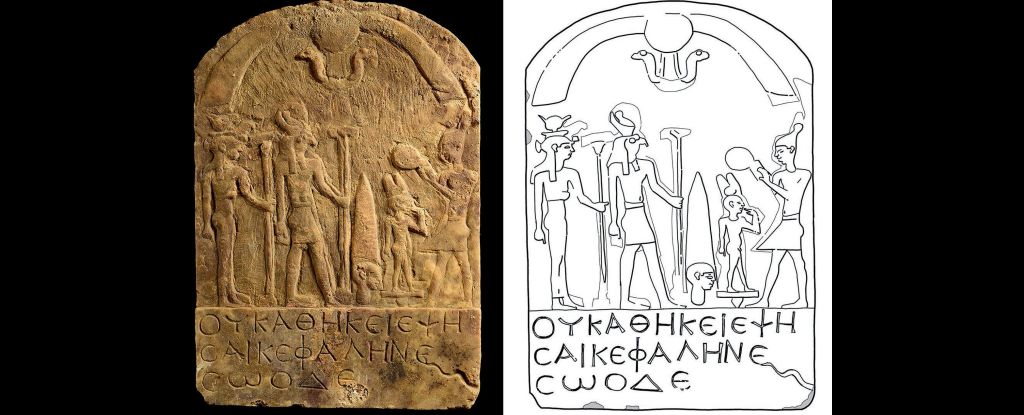Products You May Like
Remains of headless falcons found at an ancient Egyptian port on the coast of the Red Sea have revealed new details about a mysterious group known as the Blemmyes, and their worship of the Moon god Khonsu.
According to an inscription found at a dig site at the Ptolemaic-Roman port of Berenike, certain aspects of religious rituals were forbidden within that sacred space – namely, the boiling of falcon heads in preparation for offering in a sacred ritual.
“It is improper,” the inscription reads, “to boil a head in here.”
Prior to its abandonment some time before the middle of the sixth century CE, Berenike was partially inhabited by the semi-nomadic Blemmyes.
The site on which the shrine was found, called the Northern Complex, is a structure consisting of a number of buildings. Within them are clues hinting at the culture and beliefs of the Blemmyes, including inscriptions naming Blemmyan kings.
“Nothing is known about the religious beliefs and practices of the Blemmyes, apart from their association with the temples of Philae and Kalabsha on the Nile,” the researchers write in their paper.
“The present shrine could show that they respected the Egyptian tradition and developed cultic practices in which falcons were offered to the Egyptian god Khonsu, in a way not attested in Egypt, but which still betrays its origins in ideas developed in the temples of the Nile Valley.”
The Falcon Shrine, as it has been named by a team of archaeologists led by Joan Oller Guzmán of the Autonomous University of Barcelona in Spain, was uncovered during fieldwork in 2019. It consists of two small, rectangular rooms, with doorways placed on a central axis, in the style of an Egyptian shrine, with Egyptian decorative elements.
In the rear room, the archaeologists identified a podium, on which a statue of the god would have been placed, and a broken stand on which offerings to the god would have been placed. Perhaps most notable, however, were 735 animal remains: fish, bird, and mammal bones, and egg shell fragments, in different places around the room.
The mammal bones, the team ascertained, were from six species: pig, donkey, dromedary, sheep, goat, and cattle. They represented 16.5 percent of the remains. The fish bones made up just 5.7 percent.
At 64.2 percent, the bulk of the remains were bird bones, from three species of falcon: peregrine falcon (Falco peregrinus), saker falcon (Falco cherrug), and common kestrel (Falco tinnunculus).
Together, they represented 15 individual birds, 13 of which had been decapitated, and 14 of which were placed at the foot of the pedestal. One peregrine falcon was found intact, carefully placed beneath an inverted vessel in a corner of the room. It’s unclear whether the birds were wild, or bred for the purpose of sacrifice, a common practice in ancient Egypt.
The egg shells, the team noted, were also identified as belonging to falcon eggs. You can see why the team named it the Falcon Shrine.
While the remains of animals mummified in ancient Egypt are often incomplete – especially raptors – the decapitation of the falcons and lack of deliberate preservation hints at a ritualistic purpose.
A significant clue to the falcon’s sacrifice could be found nearby in the form of an excellently preserved stone tablet, or stele. On it, a relief depicts a pharaoh making an offering to three gods: Harpocrates, the child-god Horus; falcon-headed god Khonsu, who is the principal god in the scene; and a goddess wearing the crown of Hathor.
For some reason, the inscription at the foot forbids the boiling of heads in that space: “It is improper to boil a head in here.”
“It is a prohibition that warns the reader not to engage in what was clearly considered a profane activity: the boiling or cooking of a head, presumably that of a falcon, within a specified place – in this case, the shrine in which it was found,” the researchers write in their paper.
“We hypothesize that the sacrificial animals were boiled before being presented to the god, perhaps to facilitate plucking their feathers, and that their heads were removed, according to the prescription on the stele.”
Taken together, the discoveries suggest that the Blemmyes – as many groups and religious traditions have done throughout history – borrowed gods and rites from other cultures and adapted them to their own rituals and beliefs.
The research has been published in the American Journal of Archaeology.
